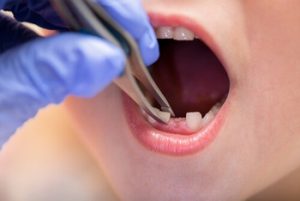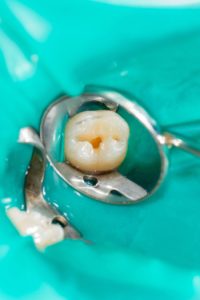Tooth extractions can be unsettling, especially when you’re unsure what the healing process should look like. If you’ve recently had a tooth extracted and noticed white stuff fell out with no pain, it’s understandable to be concerned. Is it a sign of trouble, or just part of your body’s normal healing process?
This blog will walk you through what’s happening inside your tooth extraction site, what the white stuff could be, and when it’s time to seek dental advice. Most importantly, we’ll help you recognise the difference between a normal part of recovery and something that may need professional attention.
Understanding the Tooth Extraction Healing Process

In the days following the procedure, that blood clot may be replaced or covered by a substance that looks white, yellowish, or creamy in colour. Often, this causes patients to worry, especially when it appears that this white stuff has fallen out, even if there’s no pain involved.
What Is the White Stuff at the Extraction Site?
The white material observed in a healing socket is usually part of the normal tooth extraction healing process. In most cases, it’s called granulation tissue, which plays a crucial role in wound healing.
This granulation tissue forms a protective barrier over the blood clot, consisting of new connective tissue, white blood cells, and developing blood vessels. It serves to protect the area, promote cell growth, and fight off bacteria.
Here are a few possibilities for what the white stuff might be:
- Granulation tissue is a sign that the healing site is progressing as expected.
- Food debris or food particles may become lodged in the socket, especially if you’re not rinsing properly.
- Plaque or bacteria, which can appear white, should be gently cleaned away with warm salt water rinses.
- Dead tissue, part of the body’s response to injury, which is sometimes sloughed off naturally.
- Socket white pus, usually indicates infection, especially if accompanied by bad taste, unusual bad breath, swelling, or discomfort.
White Stuff Fell Out – But There’s No Pain. Should I Worry?
If the white stuff fell out, and you’re not experiencing pain, it’s generally not a reason to panic. Pain is often the most telling sign of a painful condition like dry socket, which occurs when the initial blood clot is dislodged too early, exposing bone and nerves.
However, if what fell out was the blood clot itself, even without pain, you should monitor the area closely. A dry socket can develop slowly, with symptoms worsening over time. Watch for these other signs:
- Throbbing pain 2–4 days after the procedure
- Visible bone in the tooth socket
- Foul taste or odour in the mouth
- Swelling or persistent bleeding
If none of these symptoms are present, and the socket looks clean and is not increasingly painful, it may just be a normal healing stage where old tissue is replaced with new gum tissue.
When It’s Not Normal: Spotting Infection or Dry Socket
While the healing process varies slightly from person to person, it’s important to be aware of conditions that may require dental care:
Dry Socket
This occurs when the blood clot that forms after the tooth extraction procedure becomes dislodged or never forms at all. The result? A painful and exposed socket, often with visible bone and a delayed healing time.
- Symptoms: Severe pain, bad breath, and a bad taste in your mouth.
- Treatment: Your dentist may apply a medicated dressing and recommend saltwater rinses or pain relief.
Infection
Although rare in healthy patients, infections can occur, especially if proper care isn’t taken post-extraction.
- Symptoms: Pus (or socket white pus), swelling, gum inflammation, fever, or persistent bleeding.
- Treatment: Requires antibiotics and follow-up with your dentist.
What’s Normal in a Healing Tooth Extraction Site?
Here are some signs that indicate your tooth extraction site is healing properly:
- A white layer or film forming over the extraction site (this is usually granulation tissue)
- Slight swelling and discomfort that gradually fades
- No excessive bleeding
- No sharp or increasing pain
- The ability to eat soft foods comfortably
- No strong bad taste or foul odour
The body’s natural healing process involves various stages. Just because something looks unusual doesn’t mean it’s a problem, especially if there’s no severe pain, bleeding, or delayed recovery.
Supporting the Healing Process: Best Practices
Your body is working hard to rebuild what was lost during the tooth extraction, and your habits can either help or hinder that process.
What You Should Do
- Stick to soft foods for the first few days
- Rinse with warm salt water (starting 24 hours post-extraction)
- Avoid sucking motions (e.g., straws, smoking)
- Keep the healing site clean, but gently
- Use prescribed or dentist-approved medications if necessary
What to Avoid
- Rinsing or spitting forcefully in the first 24 hours
- Touching the extraction site with your fingers or tongue
- Eating crunchy or spicy foods that may irritate the wound
- Brushing the socket directly
- Proper dental care is crucial in allowing the gum tissue, nerves, and bone to rebuild in a controlled, infection-free environment.
What to Expect During the Tooth Extraction Healing Process

Day 1: Blood Clot Formation
- A protective blood clot begins to form in the empty tooth socket.
- Mild bleeding and swelling are common and expected.
- The blood clot acts as a plug, shielding nerves, sealing the wound, and initiating the body’s healing process.
Days 2–3: Granulation Tissue Begins to Form
- You may notice white material at the extraction site, which is typically called granulation tissue.
- This tissue is made up of white blood cells, collagen, and blood vessels, which are all working to protect the healing site and support regeneration.
- Seeing white stuff is usually a good sign, even if it looks unusual.
Days 4–7: Discomfort Decreases, Healing Accelerates
- Swelling and discomfort begin to fade.
- The granulation tissue plays an important role by providing structure and fighting off bacteria.
- New gum tissue begins to form, helping to seal and protect the socket.
- Any food debris or food particles left behind should be gently rinsed out with warm salt water.
Week 2: Deeper Gum Healing
- The risk of dry socket is significantly reduced if the blood clot remains intact.
- The gum tissue continues rebuilding, and most patients can resume regular routines and eat more than just soft foods.
- The healing socket should show signs of normal healing, without excessive bleeding, severe pain, or visible bone.
Weeks 3–4: Bone Repair Underway
- The bone beneath the surface of the socket continues regenerating.
- This stage may not be visible, but it’s a critical part of the healing for those considering future implants after wisdom teeth removed or any tooth extractions.
Month 3: Long-Term Recovery
- The socket is typically filled with new bone and fully closed by gum tissue.
- If you had a tooth extracted as preparation for a dental implant, this is often when your dentist will evaluate the healing site.
- If you’re still noticing white stuff or changes in taste in your mouth, it’s worth checking in with your dentist to ensure the area is still healing properly.
If, at any point, you’re experiencing painful symptoms, bad breath, a bad taste, or signs of infection such as socket white pus, don’t wait. These could indicate dry sockets, gum inflammation, or other issues that require dental care. Even if you feel fine, like in cases where the tooth extraction white stuff fell out, and no pain is present, it’s still wise to keep an eye out for any other signs that your body’s response might be off course.
Why Granulation Tissue Plays a Key Role
Let’s look closer at this crucial step. Granulation tissue is often misunderstood. It might look odd or even alarming, but it’s a good sign that your body is repairing the area effectively.
This tissue is made of:
- White blood cells, which prevent infection
- New blood vessels, which nourish the healing socket
- Collagen, which rebuilds gum tissue
If this white stuff detaches on its own and you’re still feeling fine, it’s probably just your body cycling through the natural stages of healing.
When to Contact a Dentist

- The white stuff is accompanied by a bad taste or odour
- You feel increasing discomfort, swelling, or heat around the socket
- Excessive bleeding continues after 48 hours
- You notice what looks like visible bone
- You feel unsure about whether the healing is progressing normally
It’s better to be cautious, especially with your oral health.
Final Word: Tooth Extraction White Stuff Fell Out, No Pain
In most cases, if white stuff falls out of your tooth extraction site and there’s no pain, it’s likely not a cause for concern. Whether it’s granulation tissue, minor food debris, or part of the body’s healing process, your mouth is simply doing what it’s meant to do.
However, if the situation changes, and you experience swelling, bad breath, a bad taste, or increasing pain, don’t wait. Contact your dentist.
To stay on track, continue following proper oral hygiene, stick to soft foods, and rinse gently with salt water. By supporting your body and monitoring the healing site, you’re giving yourself the best chance at smooth, complication-free recovery.
If you’re concerned about white stuff falling out after a tooth extraction or want peace of mind about your healing, book a consultation or call (08) 7078 8263.
Resources
Alhajj, M. & Goyal, A. (2022). ‘Physiology, Granulation Tissue’. National Center for Biotechnology Information (NCBI), 24 October. Bethesda, MD: StatPearls Publishing. https://www.ncbi.nlm.nih.gov/books/NBK554402/
Dunkin, M. A. (2023). ‘Pulling a Tooth (Tooth Extraction)’. WebMD, 30 March. New York, NY: WebMD LLC. https://www.webmd.com/oral-health/pulling-a-tooth-tooth-extraction
Colgate Staff. (2023). ‘Tips for Preventing and Treating Dry Socket’. Colgate, 9 January. New York, NY: Colgate-Palmolive Company. https://www.colgate.com/en-us/oral-health/wisdom-teeth/dry-socket-more-painful-than-the-tooth-extraction
Mayo Clinic Staff. (2023). ‘Bad Breath’. Mayo Clinic, 21 December. Rochester, MN: Mayo Foundation for Medical Education and Research. https://www.mayoclinic.org/diseases-conditions/bad-breath/symptoms-causes/syc-20350922
Note: Any surgical or invasive procedure carries risks. Before proceeding, you should seek a second opinion from an appropriately qualified health practitioner.

